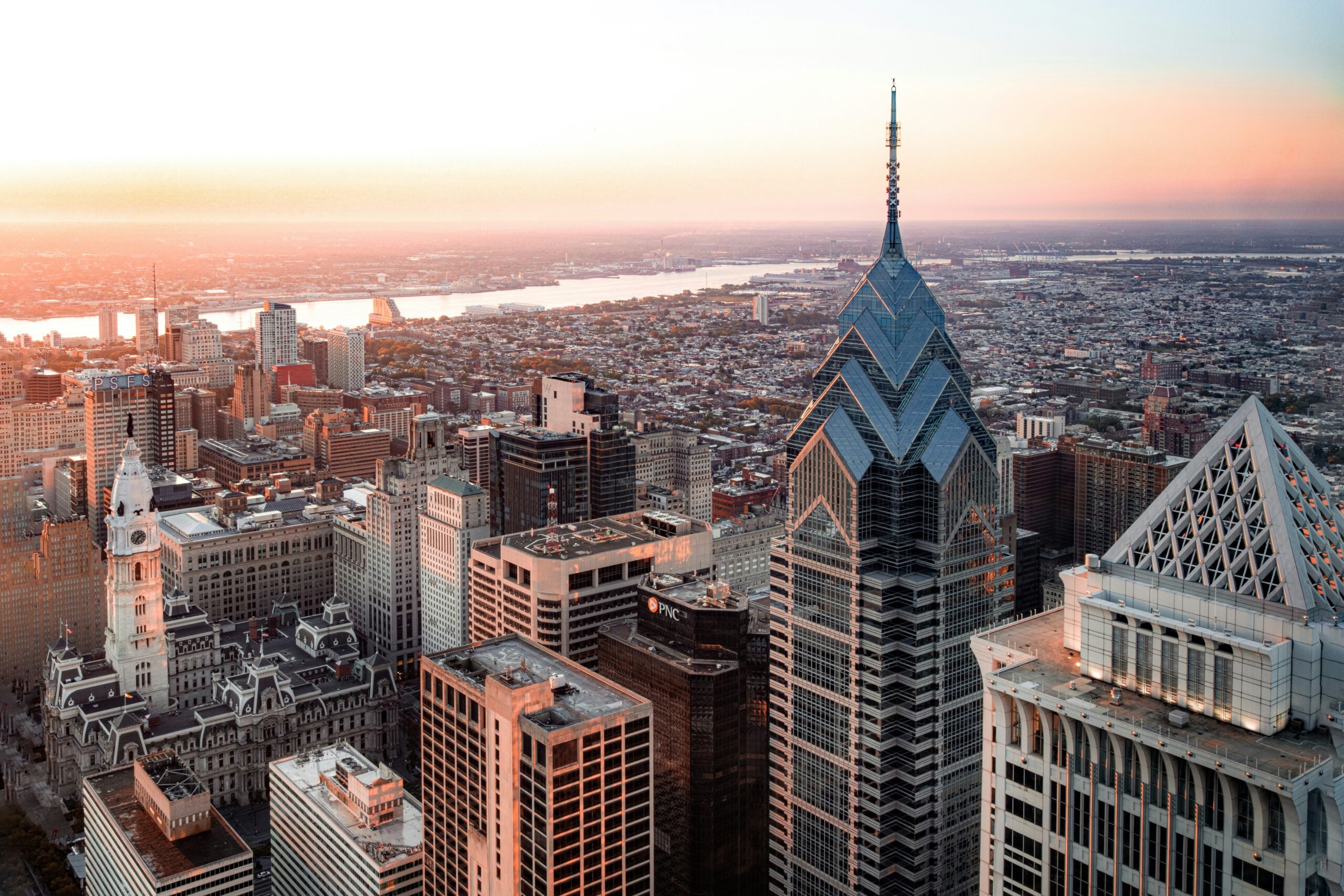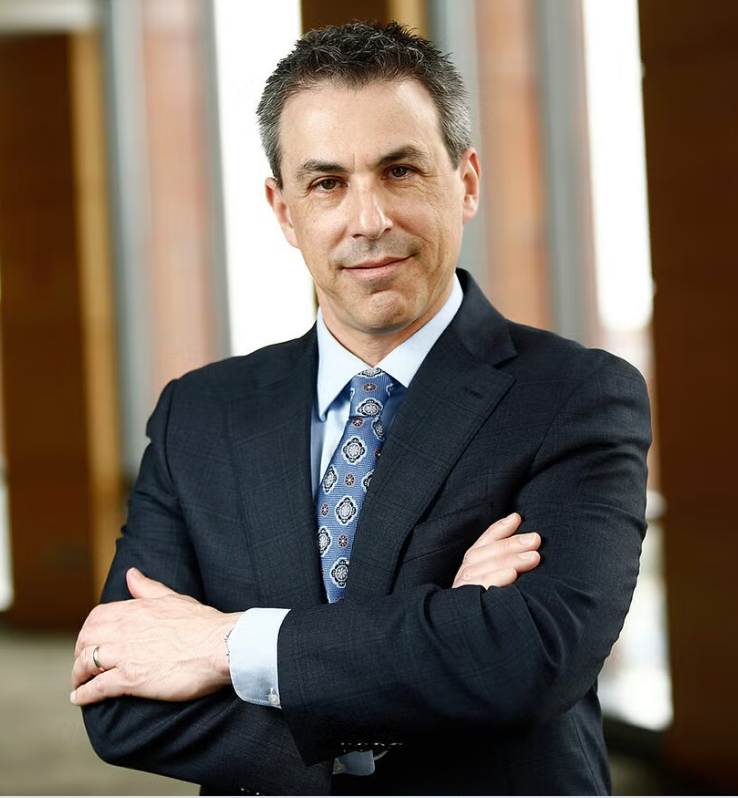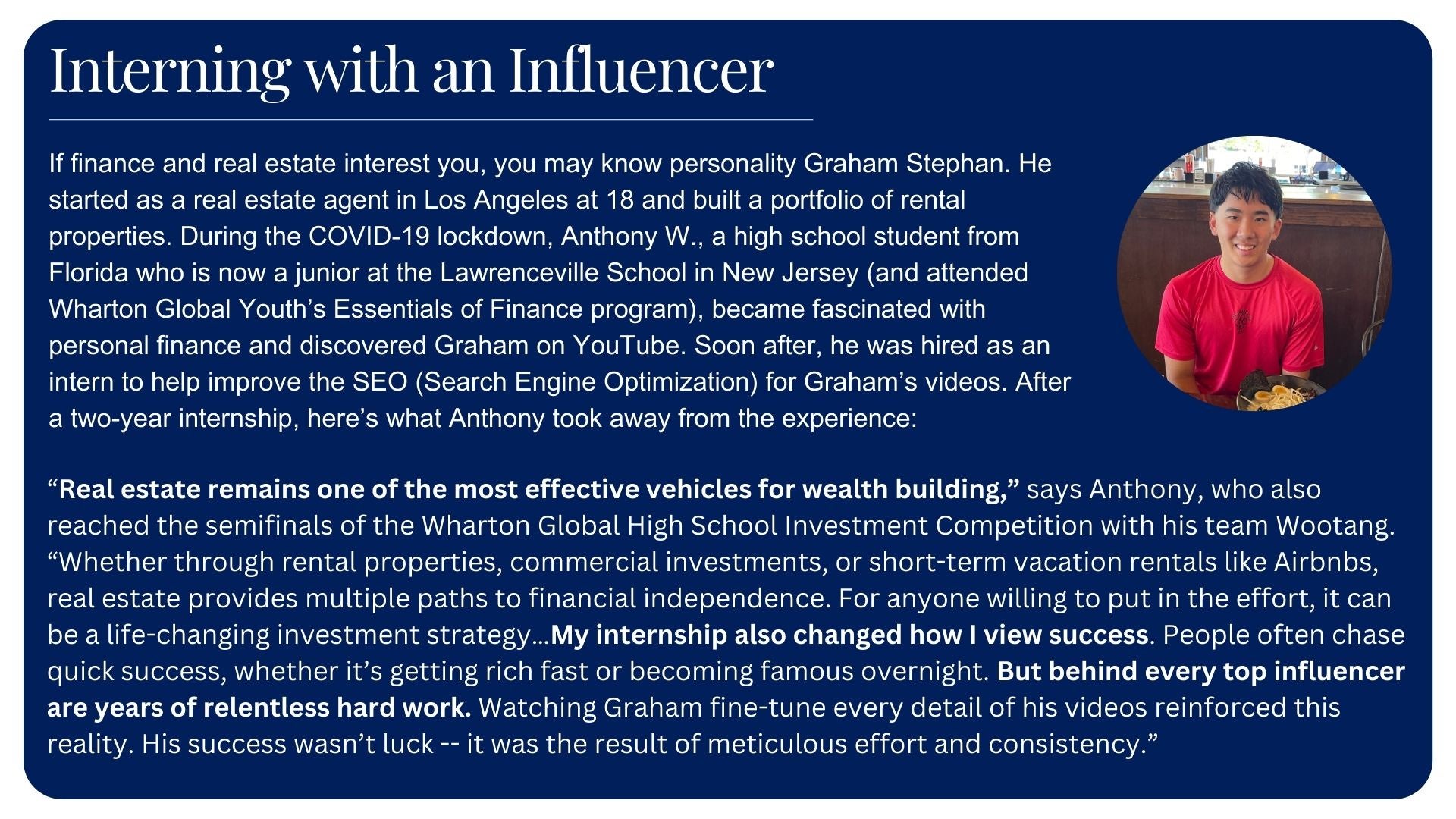Skyscrapers and Shopping Malls: How Commercial Real Estate Shapes Your World


When Wharton Global Youth met up with Margaux D.K., a Wharton School senior at the University of Pennsylvania who is heading into a real estate career, she defined her passion for real estate like this: “I appreciate that we are investing in something tangible and helping to shape communities.”
Think about that neighborhood vision for a moment, in particular an urban streetscape or skyline (after all, Wharton is based in the city of Philadelphia — pictured above). Perhaps shaping of communities involves designing and constructing a new 20-story apartment building from the ground up or converting a vacant Baptist church into condominiums or a new charter school. Or maybe that real estate project requires even more creative thinking, like turning Philadelphia’s 40-acre, 40 building historic Arsenal (a property on the market for redevelopment) into a campus for living, working, retail, restaurants and more.
All of these deals are examples of commercial real estate – what you might call the other side of the business from residential — or buying and selling houses. (Get a greater glimpse of the global commercial real estate marketplace at LoopNet.com.)
Commercial real estate, according to Wharton’s Todd Sinai, is income-producing real estate that is invested in, rather than owner-occupied housing. “This includes properties like apartment buildings, hotels, warehouses, retail malls and office buildings,” noted Dr. Sinai, a professor of real estate, business ethics and public policy, during a lecture he gave to Wharton Global Youth students who were studying on Wharton’s campus. “The key distinction is that commercial real estate generates income through rent paid by tenants, whereas owner-occupied housing does not produce income. Commercial real estate is considered an investment, where the goal is to generate returns.”

What should we understand about this dynamic and diverse asset class, otherwise known as commercial real estate? Professor Sinai shared these 6 insights:
1️⃣ The Wharton School focuses its academic study in this area on real estate finance. “Our students [like Margaux, an undergrad, as well as graduate MBAs] invest in commercial real estate. They are working at or running companies that own portfolios of properties. They buy and sell properties, and those properties might be anywhere from $5 million to $500 million or $1 billion,” noted Sinai. “Our students become investors. They become brokers, matching buyers and sellers of real estate. They lend, making loans on real estate. They’re investment bankers. And they build new real estate.”
2️⃣ The U.S. has $18 to $22 trillion of commercial, income-producing real estate. It has much, much more owner-occupied housing.
3️⃣ Return on investment is the cash flow that you get while you hold an investment, and then however much you get for it when you sell it, compared to how much you paid for it. “Real estate is no different,” said Sinai. “The cash flow that you get on real estate is the rent that tenants pay you, minus the expenses that you have to pay for running a building. And at some point, if you sell the property, someone else is going to decide how much to pay you for it. And then you’ll sell it to someone. So, that gives you your return — it’s dividends, which, in the real estate case is rent. And it’s capital gains: how much more did you sell it for than what you paid for it?”
4️⃣ It’s valuable to understand the economics of real estate markets, like the concentration of population in metropolitan areas and what makes people willing to pay a premium to live and work in certain locations – as Sinai asked: “What drives the value of the underlying real estate?”
5️⃣ Performance can vary across different real estate sectors. “You try and manage around the cycle in real estate; it’s very cyclical,” noted Sinai. “You have these crashes that are driven by building more than what you need. For example, warehouse prices are really high; we’re building a ton of them right now. Warehouse demand is really high, so we’re filling them. At some point we are going to keep building warehouses, and they’re going to stop getting full. You look for factors like how quickly the space gets rented, how many tenants are competing for the same base and other measures like how tight the market is. But it’s genuinely hard to tell [when demand will drop off].”
6️⃣ Disruptive trends like e-commerce (not as many trips to the retail mall), working from home (fewer days in the office high-rise) and climate change (shifting flood zones around buildings) are impacting the commercial real estate market and investors. “In Miami, a six-foot rise in sea level all of sudden changes where you might want to have property in Florida,” observed Sinai. “They calculate that a 20-foot sea wall would be needed to protect the city from climate change, which blocks the views out of the first two floors of anything that’s oceanside. That changes the value of the existing real estate. E-commerce changes where people want to shop. All these things are an upheaval right now, which makes it an interesting time to be doing real estate.”

How does commercial real estate differ from residential real estate?
Has a commercial real estate project around your neighborhood caught your eye recently? Describe it in the comment section of this article and think about it from a business perspective? What questions bubble up for you around this reshaping of your community?
High school student Anthony W. says, “Behind every influencer are years of relentless hard work.” Do you agree with him? Why or why not?
Hero image photo of the Philadelphia skyline shot by: ActionVance on Unsplash
Commercial real estate’s value hinges on cash flow stability and location dynamics, but rising climate risks like Miami’s sea-level rise add a complex layer of long-term valuation challenges. This forces investors to rethink risk models and asset strategies beyond traditional supply-demand cycles. It’s a prime example of how external factors reshape financial assumptions in real assets.
Professor Sinai’s explanation of commercial real estate added a new layer to how I think about the spaces that surround me. I’ve always understood that offices, apartment buildings, and retail centers are investments, but his breakdown of how performance is measured through rent, operating costs, and resale value helped me think more analytically about how those properties actually function over time. His point about the difficulty of predicting performance across real estate cycles made me realize how much strategy and timing are involved, and how easily even a strong asset can fall short if market conditions shift.
Wells Fargo’s decision to construct a new office campus in the Dallas Fort Worth area has stayed on my mind. While many companies are reducing their physical footprints in favor of hybrid work, they made the opposite choice and committed to building something permanent. That kind of decision reflects more than just optimism. It likely involved long-term modeling, projections about regional growth, and a belief that controlling their own physical environment would give them an edge. I find myself wondering what assumptions they made about future demand, how they approached risk, and what tradeoffs they accepted in exchange for that level of control.
Dr. Wong’s lecture through Wharton Global Youth Meetup (GYM) gave me the tools to think through these kinds of questions more deeply. She emphasized how real estate professionals must manage uncertainty while staying grounded in data and financial discipline. Her walkthrough of property-level analysis, including gross potential income, vacancy loss, capital expenses, and projected sale value, gave me a clearer sense of how returns are modeled. But what stuck with me even more was her reminder that real estate also requires creativity and people skills. Knowing how to make a property more attractive to tenants, or how to reimagine the best use of a site, often determines whether a deal succeeds or fails.
That broader understanding helped me connect Professor Sinai’s insights to what is happening in the real world. The article’s mention of e-commerce, climate change, and the changing role of office buildings shows how many outside forces are constantly reshaping commercial real estate. Dr. Wong spoke about how strong investors can read those shifts and adjust, whether that means investing in data centers to meet rising digital demand or rethinking how office space is designed to support more flexible work models. Every project is a reflection of these decisions, even if that is not immediately visible from the outside.
Anthony W.’s quote about relentless hard work ties all of this together. Real estate can seem like it is just about funding or design, but the reality is much more complex. Behind every successful development is someone who kept working through setbacks, adjusting spreadsheets, coordinating with city planners, and managing risk day after day. That kind of effort rarely gets attention, but it is what shapes the physical world around us. Commercial real estate is challenging, unpredictable, and deeply rewarding. That combination is what draws me in and is why I want to keep exploring it more deeply.
The article’s description of commercial real estate (CRE) as more than structures—but as ecosystems that influence social behavior, business clusters, and civic life—was true.
I was particularly drawn to the thesis that mixed-use projects give rise to “walkable districts” that integrate living, shopping, and culture. It reminded me of platform strategy in fintech: just as apps thrive by offering differentiated but related services (e.g., payment, lending, analytics), CRE systems thrive by integrating services that are sticky and self-sustaining.
My own development experience working with data models in AWS and Python also supports this notion of thinking ecosystems. In assessing SMS-based microfinancing utilization, linking peer-to-peer lending with localized financial education modules increased user retention by 18%. Similarly, lucid CRE projects are capable of fostering community loyalty, driving foot traffic, and diversifying revenue streams.
The article’s exploration of “retail apocalypse” and risk of vacancy concerns resonated similarly. It asked a sharp question: With remote work and online shopping remodeling demand, how do CRE developers leverage fast, data-fueled project cycles—like fintech MVPs—to repurpose or re-skill buildings in bulk? To take one example, could mall vacancy be rapidly converted into co-working facilities, micro-fulfillment hubs, or community classrooms?
Your reference to changes in consumer behavior solidified the idea that real estate, much like technology, must keep up in responsive fashion.
Appreciation for a provocative look at CRE’s influence—not just on skylines, but on how we work and live.
Final question: what emerging data tools or analytics platforms (e.g., occupancy sensors, foot-traffic APIs, retail performance dashboards) are most effective in enabling real estate teams to adjust use in near real-time?
While both residential and commercial real estate can both be considered vehicles for investment, residential real estate investment is limited to a person’s primary residence and they can only potentially gain money when they sell it. However, with commercial real estate, a person or company has opportunities to generate income while still holding ownership rights to the property, in addition to when they sell it.
As someone who has spent most of my life in Hangzhou, China, but spent the past few years studying in America, it is interesting to compare business in both these areas. Although commercial real estate is typically considered a good investment, I think it varies based on economic conditions and trends. Just last year, Wanda, a large conglomerate that works across multiple industries sold Wanda Plaza in the Gongshu District of my home city to an investment fund at a very low price (1.48 billion yuan). It included office buildings and stores since there has been high vacancy rates due to low consumer demand for retail shopping. Due to their economic situation, they have had to adapt and adopt a leaner asset portfolio, especially when it comes to commercial real estate.
With less demand for brick-and-mortar shopping and luxury consumption, I predict that more retail malls will close. In their place, we have continued to see more investment in residential communities that are either selling second-hand houses or renting since China’s housing bubble burst. China used to sell a lot of houses, but due to regulatory changes the house-buying market has also cooled. As a result, I think more people will spend more time in their housing communities instead of at shopping malls and we may see new trends emerge as a result in the future.
A few months ago, I visited Uông Bí, a small city in northern Vietnam known for its coal mines. Apart from the mines, I noticed large logistics parks being built. The first warehouses had just opened a few weeks earlier, right after a new highway opened, and more kept appearing. The warehouses were constructed in phases. Between each phase, the highway system nearby was also developed. This system connects the industrial complex to shopping malls, schools, residential areas, and hospitals, making the entire park more attractive to new tenants. Though more warehouse supply was added, the surging demand from the new facilities made the whole area more and more expensive.
It reminded me of something Nalin said above about real estate being a strategic game. I could see that the developers were following a plan to profit the most from the investment: they only built new phases when prices got too high and no one wanted to rent anymore. In other words, by building in stages, they could test tenant interest, raise rents, and get better financing for the next phase. But I also wondered: who actually gains the most from this kind of development? It’s clear that each new phase brings more profit—but mostly for the developers. What about other stakeholders? Industrial parks often come with security checkpoints, fenced perimeters, and wide truck roads, which create barriers for small businesses, local workers, and nearby communities to connect. Ironically, the “connection” (highway) was what make this park so attractive in the first place.
With that in mind, I have a question to pose: How can we build CRE that increases value for both the land and the people?
I truly appreciate your comment, as it highlights the tension between a desire for profit and genuine community uplift. Perhaps, while aiming to achieve both, we should focus on ensuring that developments have mixed uses in the forms of adaptive spaces, shared infrastructure and local equity stakes. It would be valuable if city planners could collaborate with developers in order to further ensure returns, but also functional community uplift. The question is, though: how should we recalibrate the incentives so developers continue pursuing returns but also start enduring human flourishing? I’m curious to hear about your thoughts on that matter.
This article helped me better understand how commercial real estate isn’t simply about rent or money, but also about building communities. It makes me think about my class on New York City History where we explored real estate developments in certain areas such as Harlem and places in Brooklyn. While investments in certain areas can lead to jobs, housing, and other opportunities for an area, they can also significantly contribute to gentrification.
I see how at Wharton, real estate is meant to help students think about transforming spaces and ultimately benefiting the people of a neighborhood. I think it is important to take into account how real estate development and commercial real estate can affect diverse populations. For example, one must take into account how much rent increases from new projects will impact those struggling to afford them.
Additionally, it is important to balance this idea of urban renewal, with preserving the identity of an area. As developers seek to make profits, their actions also drive people out as property value increases. Simultaneously, boutique shops and restaurants will be replaced with chain stores that cater to the wealthy. This article made me want to learn about how developers are keeping into account the identity of a neighborhood and if it is possible to avoid full gentrification along with making money in real estate. Mindful developers create commercial real estate that can be profitable but also have an ethical responsibility.
Investors need to begin to question how they can build models to also account for the lower and middle classes in a neighborhood. In New York, for decades people have been driven out of their neighborhoods from places like the South Bronx and Harlem. In the future, new conversations need to be had about striking a balance.